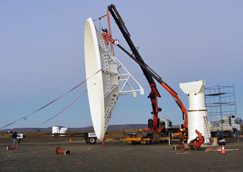KAT-7 telescope gets first antenna
21 July 2009
In a major boost for South Africa's ambitions to host the Square Kilometre Array (SKA), a construction team worked into the night last week to install the first antenna of the KAT-7, a seven-dish prototype of the SKA, near Carnarvon in the Northern Cape province.
The Square Kilometre Array (SKA) is a planned future-generation international radio telescope that will enable astronomers to probe the early evolution of our galaxy. It will comprise about 3 000 antennas that, put together, would cover a square kilometre.
The network of dishes will be at least 50 times more powerful than any existing telescope, and will cost an estimated €1.5-billion to build.
South Africa is currently in a race against Australia to be selected as the preferred site for the SKA, the two countries having beaten bids from Argentina and China to make the SKA shortlist.
The International SKA steering committee in the Netherlands is expected to make a final decision on the host country in 2012.
Engineering test-bed
The construction of the KAT-7 prototype array at the site in a remote area of the Karoo follows the successful building and testing of a single-dish prototype at the Hartebeesthoek Radio Astronomy Observatory near Johannesburg.
It is thought to be an important phase in the development of the more powerful MeerKAT, which will be commissioned in 2013.
"KAT-7 will primarily be an engineering test-bed, but will also be capable of scientific observations and will be the first seven antennas of the full MeerKAT array," the local Square Kilometre Array project team said in a statement.
MeerKAT
The construction and commissioning of the full MeerKAT array, an important precursor instrument to the Square Kilometre Array, will follow at the same site.
The completed MeerKAT will be one of the most powerful telescopes in the world in its own right, consisting of 80 dishes, with a high-speed data network linking the telescope site in the Karoo to a control centre in Cape Town.
MeerKAT will be the most sensitive centimetre-wavelength radio telescope in the southern hemisphere, and will make significant contributions to both galactic and extragalactic astronomical research.
If South Africa were to win the SKA bid, it could generate over R500-million in foreign investment in the country.
It would bring a massive injection of expertise and economic activity to the Northern Cape, with benefits for the local aluminium, computer, communications, electronics and steel industries.
SAinfo reporter
Would you like to use this article in your publication or on your website? See: Using SAinfo material







 Facebook
Facebook Twitter
Twitter Mobile
Mobile RSS feeds
RSS feeds Newsletter
Newsletter Weblines
Weblines